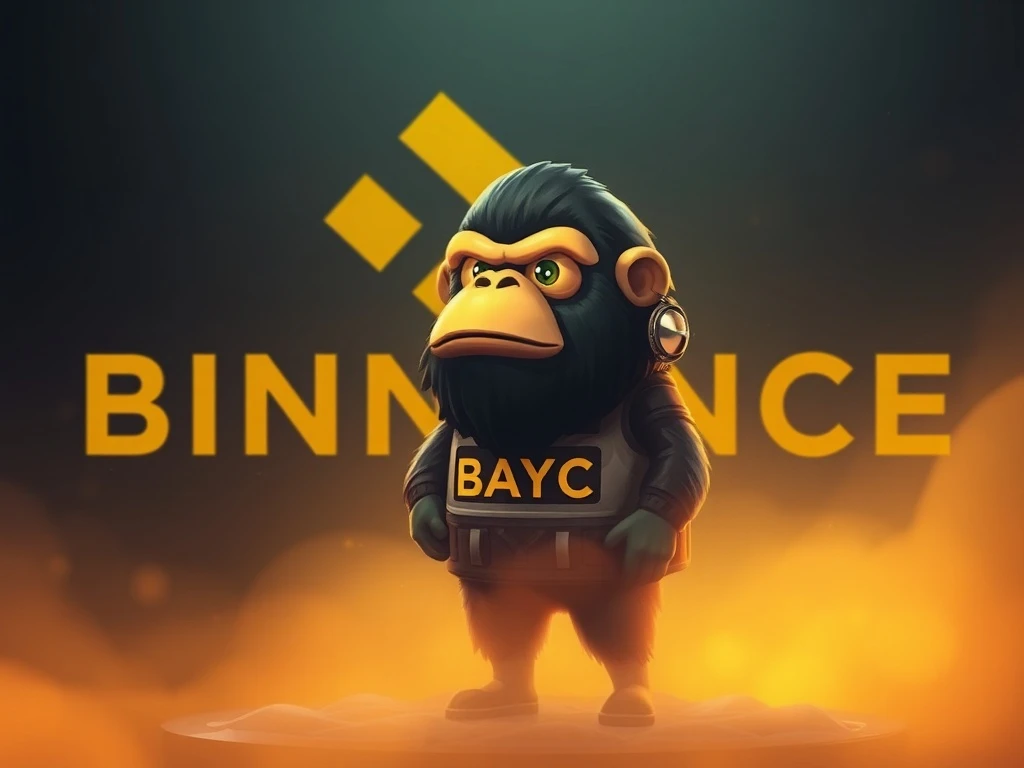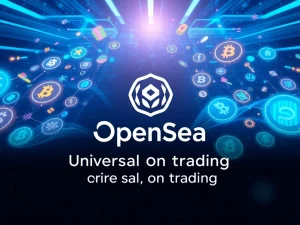Crucial Update: Binance NFT Staking Ceases for BAYC & MAYC by August 2025

A significant shift is underway in the NFT space, directly impacting holders of two of the most iconic collections: Bored Ape Yacht Club (BAYC) and Mutant Ape Yacht Club (MAYC). Binance NFT, a major player in the digital collectibles arena, has announced the discontinuation of its Binance NFT staking programs for these prominent NFTs. This pivotal decision, effective August 1, 2025, stems from necessary adjustments to the underlying APE NFT staking mechanism.
What’s Happening with Binance NFT Staking?
On July 25, 2025, Binance NFT officially communicated its plan to cease its staking services for BAYC and MAYC NFTs. This means that by August 1, 2025, users who have been staking their valuable Bored Apes and Mutant Apes on the platform will no longer earn rewards through this program. According to Binance’s timeline, all affected NFTs will be returned to their respective owners’ accounts by August 3, 2025.
The primary driver behind this move is the evolving landscape of the APE NFT staking mechanism itself. As the broader APE ecosystem undergoes changes, platforms like Binance must adapt to maintain compliance and align their offerings with the foundational protocols. This recalibration highlights the dynamic nature of the Web3 space, where constant evolution requires platforms to be agile and responsive.
Why is Binance Ending BAYC Staking?
The core reason cited by Binance is the need to adjust to the evolving APE staking mechanism. The APE token, which underpins the Bored Ape and Mutant Ape ecosystems, has its own set of rules and protocols for staking. As these protocols are updated or refined, platforms offering staking services must follow suit. This ensures interoperability and adherence to the project’s vision.
This decision underscores a broader challenge faced by centralized platforms in the decentralized world: balancing user convenience with the need to adapt to rapidly changing project-level mechanisms. While staking programs typically incentivize long-term holding by offering rewards, their cessation can trigger discussions about the efficiency and adaptability of such platforms in the face of underlying blockchain project updates.
The Impact on MAYC Staking and NFT Liquidity
The discontinuation of MAYC staking, alongside BAYC, is expected to have several ripple effects, particularly concerning liquidity dynamics within the broader NFT market. Staking programs often lock up a significant portion of a collection’s supply, reducing immediate selling pressure and contributing to price stability. With these NFTs being returned to user wallets, there’s a potential for increased liquidity, which could lead to shifts in market prices.
Analysts are closely monitoring the situation, noting that such changes frequently provoke shifts in investor behavior. While the immediate financial impact on BAYC and MAYC holders remains to be fully seen, historical precedents suggest that major platform adjustments can influence market sentiment and trading activity. It’s crucial for holders to assess their individual strategies as this transition unfolds.
Navigating NFT Market Dynamics Post-Staking
This development is a stark reminder of the ever-evolving NFT market dynamics. For investors and enthusiasts, understanding these shifts is paramount. The cessation of staking services for such high-profile collections prompts questions about the long-term utility and adoption of NFTs, especially when tied to specific platform services.
Key considerations for the community include:
- Liquidity Shift: Will the return of staked NFTs lead to increased trading volume or selling pressure?
- Investor Behavior: How will holders adapt their strategies? Will they seek alternative staking solutions, or will this encourage direct peer-to-peer holding?
- Platform Adaptability: How will other platforms navigate similar challenges as underlying NFT project mechanisms evolve?
- APE Token Volatility: While Binance’s announcement doesn’t directly reference effects on APE’s price, historical trends suggest market sensitivity to structural changes in staking protocols.
The broader NFT community will scrutinize how platforms like Binance navigate similar adjustments, particularly as the market evolves toward more dynamic and project-specific governance models.
What’s Next for BAYC and MAYC Holders?
While Binance’s announcement provides a clear timeline for the return of NFTs, it does not include explicit guidance on post-cessation strategies for BAYC or MAYC holders. This places the onus on individual investors to prepare for the transition period and decide on their next steps.
Here are some actionable insights for affected users:
- Monitor Your Wallet: Ensure your Binance account is secure and ready to receive your NFTs by August 3, 2025.
- Research Alternatives: Explore other potential avenues for utilizing your BAYC or MAYC NFTs, such as self-custody in cold wallets, or investigating other decentralized staking opportunities if they arise.
- Stay Informed: Keep an eye on official announcements from Yuga Labs (creators of BAYC/MAYC) and the APE DAO for any updates regarding future staking mechanisms or utility for APE NFTs.
- Assess Your Strategy: Re-evaluate your long-term investment strategy for these assets in light of this change.
This move by Binance is a significant event, highlighting the ongoing maturation and challenges within the NFT ecosystem. It serves as a crucial reminder for all participants to remain vigilant and adaptable in this fast-paced digital frontier.
Conclusion: Adapting to the Evolving NFT Landscape
Binance NFT’s decision to discontinue BAYC and MAYC staking programs marks a pivotal moment, reflecting the continuous evolution of the NFT and decentralized finance sectors. While it signals an end to a specific service, it also underscores the resilience and adaptability required from both platforms and users in this dynamic space. The transition period offers an opportunity for holders to recalibrate their strategies and for the broader community to observe how the market reacts to such fundamental changes. As the NFT ecosystem matures, these adjustments are not merely disruptions but crucial steps in defining the future utility and governance of digital assets.
Frequently Asked Questions (FAQs)
Q1: Why is Binance NFT discontinuing BAYC and MAYC staking?
A1: Binance NFT is discontinuing these staking programs primarily due to necessary adjustments and evolving mechanisms within the underlying APE NFT staking protocol. This ensures the platform remains aligned with the project’s foundational rules.
Q2: When will the BAYC and MAYC NFTs be returned to users?
A2: According to Binance’s timeline, all affected BAYC and MAYC NFTs will be returned to users’ accounts by August 3, 2025.
Q3: What should BAYC and MAYC holders do after the staking ends?
A3: Holders should ensure their Binance accounts are secure to receive their NFTs. It’s advisable to research alternative storage solutions (like cold wallets) or explore any new decentralized staking opportunities that may emerge. Monitoring official announcements from Yuga Labs and the APE DAO is also recommended.
Q4: How might this impact the liquidity and price of BAYC and MAYC NFTs?
A4: The cessation of staking could potentially increase the circulating supply of these NFTs, which might lead to shifts in market liquidity and price. Analysts suggest such changes can influence investor behavior, but the immediate financial impact requires further observation of market reactions.
Q5: Will this affect the APE token’s price?
A5: While Binance’s announcement doesn’t directly address APE’s price performance, historical trends suggest that market sensitivity to structural changes in staking protocols can influence the token’s volatility. Investors are advised to monitor related projects for further updates.
Q6: Are there any alternative platforms for BAYC or MAYC staking?
A6: The announcement from Binance does not specify alternative platforms. Holders should research the broader NFT ecosystem and official APE staking mechanisms for any future decentralized or third-party staking opportunities that might align with the evolving APE protocol.









